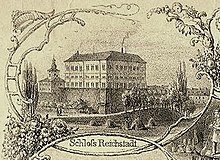
The Reichstadt Agreement was an agreement made between Austria-Hungary and the Russian Empire in July 1876. Both were then in an alliance with each other and the German Empire in the League of the Three Emperors, or Dreikaiserbund. Present were the Russian and Austro-Hungarian emperors together with their foreign ministers, Prince Alexander Gorchakov of Russia and Count Gyula Andrássy of Austria-Hungary. The closed meeting took place on July 8 in the Bohemian city of Reichstadt (now Zákupy). They agreed on a common approach to the solution of the Eastern Question because of the unrest in the Ottoman Empire and the interests of the two major powers in the Balkans. They discussed the likely Russo-Turkish War its possible outcomes and what should happen under each scenario.
The later Budapest Convention of 1877 confirmed the main points, but when the war concluded with the Treaty of San Stefano in 1878, the terms of the treaty were quite different, which led to Austro-Hungarian insistence on convening a revision at the Congress of Berlin later that year. Those events laid the background for the subsequent Bulgarian Crisis of 1885-1888 and ultimately World War I.
Format
The negotiations took place in a private and almost informal setting. It is significant that the results of the meeting were not written down and so the Austro-Hungarian and the Russian views of what was agreed on differed significantly.
There was never a signed formal convention or even a signed protocol. The minutes were dictated separately by both Andrássy and by Gorchakov, which suggests that neither side really trusted the other. The extent of the agreed Austro-Hungarian annexation in Bosnia and Herzegovina has remained controversial. It was those inconsistencies that necessitated further discussions at the Constantinople Conference and the subsequent Budapest Convention, but they largely confirmed or amended the Reichstadt discussions.
Terms
The Balkan Christians would gain a measure of independence.
Austria-Hungary would allow Russia to make gains in Bessarabia and the Caucasus.
Russia would allow Austria-Hungary to gain Bosnia.
Russia and Austria-Hungary would not create a large Slavic state in the Balkans.
Implications
The agreement effectively meant that Austria-Hungary was assuring Russia that it would stay out of a war between Russia and the Ottoman Empire. It also meant that Austria-Hungary and Russia were agreeing on how the Balkans would be divided in the case of a Russian victory.
See also
References
- Ragsdale, Hugh, ed. (1993). Imperial Russian Foreign Policy. Woodrow Wilson Center Press. Cambridge University Press. ISBN 9780521442299.
- Kellogg, Frederick (1995). The Road to Romanian Independence. Purdue University Press. ISBN 9781557530653.
- Mikulas Fabry. The Idea of National Self-Determination and The Recognition of New States at The Congress Of Berlin (1878) Archived 2008-06-21 at the Wayback Machine. ISA Annual Convention, New Orleans, March 24–27, 2002
- Pribram, Alfred, ed. (1921). The Secret Treaties of Austria-Hungary. Vol. 2. Harvard University Press.
Bibliography
- Crampton, R. J. A Concise History of Bulgaria. Cambridge University Press 1997
- Beller, Steven. A Concise History of Austria. Cambridge University Press 2007 ISBN 9780521473057
| Great Eastern Crisis | ||||||||||||
|---|---|---|---|---|---|---|---|---|---|---|---|---|
| Wars and conflicts |
| |||||||||||
| International agreements | ||||||||||||
| See also |
| |||||||||||



